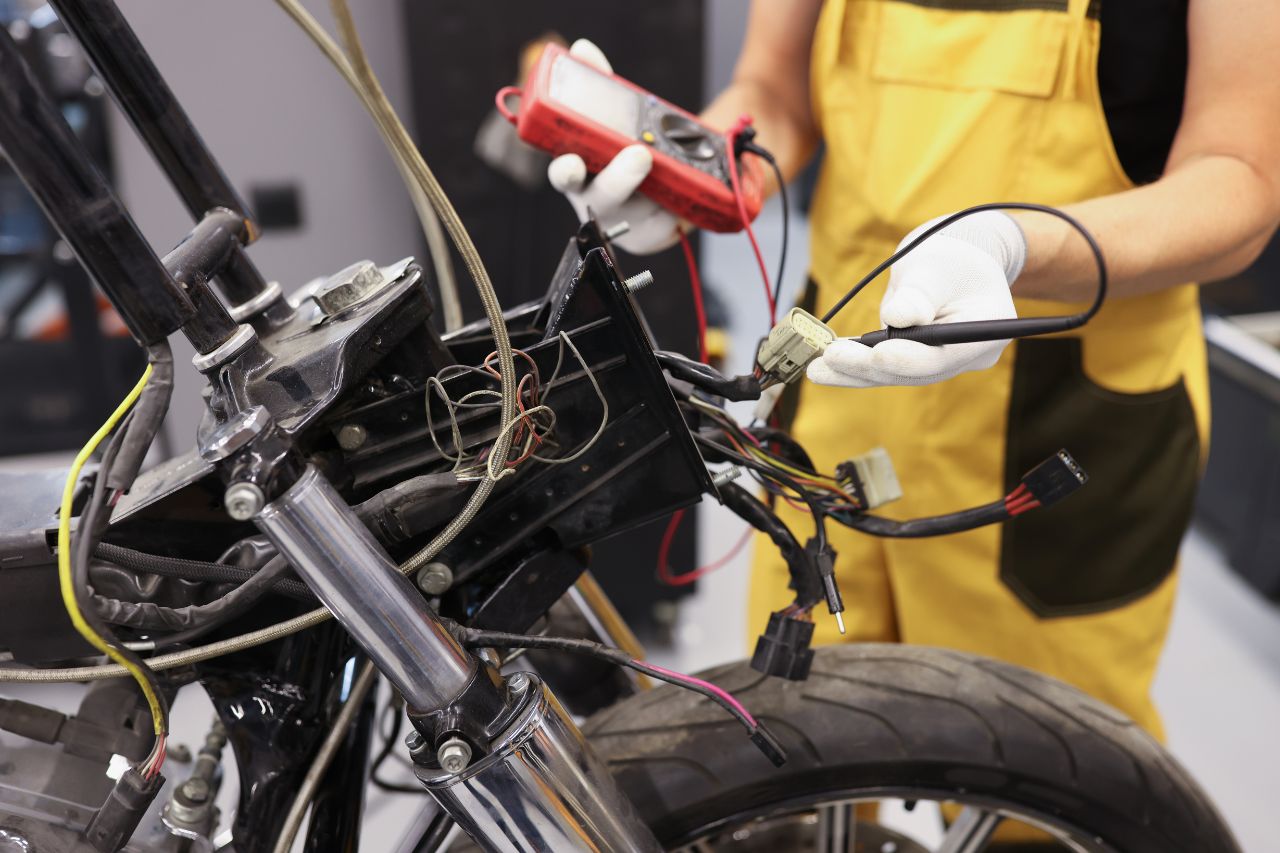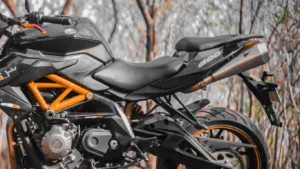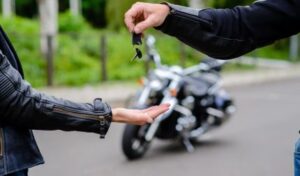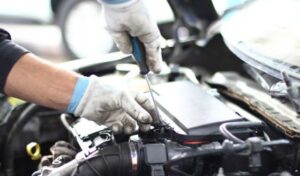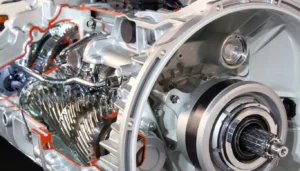Ever connected your motorcycle battery and noticed some sparks flying? This can be quite alarming, but don’t go into panic mode yet. Understanding why this happens and how to prevent it is key. And that’s precisely what this article is about: unpacking the reasons ‘why is my motorcycle battery sparks when I hook it up?’
Remember, playing with electricity is not a game. Always take necessary precautions when handling any electrical components.
Before delving into the reasons, let’s first run through the process of hooking up a motorcycle battery.
- Locate your motorcycle’s battery. It’s typically found under the seat or behind a side cover.
- Identify the positive (usually red) and negative (usually black) terminals on the battery.
- Connect the positive cable to the positive terminal of your battery.
- Lastly, connect the negative cable to the negative terminal.
Here’s the deal: If you see sparks during or after step 4, that’s your cue to stop and figure out the cause. Ignoring this could result in serious damage to your motorcycle or even personal harm.
- Short Circuit: A common cause of sparks is a short circuit, caused by a problem in your motorcycle’s wiring.
- Incorrect Order: If you connect the negative terminal before the positive terminal, this can also generate sparks.
Now that you’re aware of the potential reasons, let’s dive into them in more detail. After all, knowledge is power, right?
Understanding the Sparking Phenomenon
Have you ever experienced a spark while hooking up your motorcycle battery and wondered about the science behind it? Well, you’re not alone. This article aims to shed light on this everyday event that many motorcyclists face. Understanding the cause is the first step to ensuring safety.
What Causes the Spark?
The basic cause of the spark lies in the properties of electricity. Much like water, electric current flows from areas of high potential (voltage) to areas of low potential. If a conductor like a battery cable comes into contact with the motorcycle battery’s terminals, the circuit completes and current flows instantaneously, causing a spark to appear.
Here’s the process broken down into simpler steps:
- The motorcycle battery is connected to the motorcycle’s electrical system while the key is off.
- The electrical components of the motorcycle, like the ignition and lighting system, are in a power-off state.
- When the battery cable makes contact with the battery’s terminal, an immediate surge in current occurs due to the components demanding power.
- This surge in current is the cause of the spark.
What Does this Mean for Me?
In normal circumstances, this spark is normal and harmless. However, in some scenarios, it can possibly lead to dangerous situations. For example, if an excessive amount of hydrogen gas has built up around the battery, this sparking can ignite the gas and cause an explosion.
“Safety should always be your number one priority, understanding the underlying reasons for common phenomena allows you to take necessary precautions.”
How to Prevent Excessive Sparking
An occasional spark is normal, but repeated or excessive sparks can cause damage to your motorcycle or even cause dangerous situations. Here are few steps to minimize sparking:
- Ensure your motorcycle is off before connecting the battery.
- Make sure to connect the positive terminal first and then the negative one.
- Make sure your battery connections are clean and corrosion-free.
- If excessive sparking continues, consider reaching out to a professional for help.
In summary, the occasional spark when hooking up your motorcycle battery is a result of the immediate flow of electrical current. It’s mostly harmless but can lead to dangerous situations under certain circumstances. As an informed motorcyclist, it’s crucial to understand what’s normal and when to seek professional help.
Common Causes of Sparking Motorcycle Batteries
If you’ve noticed a spark when hooking up your motorcycle battery, it’s a clear indication something is off. Not only does this pose a risk of electrical shock, but it can also potentially harm your motorcycle’s electrical system. Below we dive deep into the common culprits behind sparking motorcycle batteries and how to fix them.
1. Reverse Polarity
The first thing to consider is reverse polarity. This happens when the positive terminal of the battery is connected to the negative pole of the battery wire, and vice versa. To put it simply, you may have connected the battery backwards.
Always remember: Red goes with red (positive); black goes with black (negative).
To fix this, simply disconnect your battery and check the terminal links. Once you’ve confirmed the positive wire is connected to the positive terminal (+) and the negative wire is connected to the negative terminal (-), you should be good to go.
2. Short Circuit
The next probable reason could be a short circuit. This occurs when an unintended, low resistance path for the electric current is made, causing an excessive amount of current to flow through. This inevitably results in a spark and could be due to faulty wiring or a blown fuse.
- Fix the wiring: Examine the wiring of your bike. Look for any visible damage like frays or cracks. If found, replace the wire or call a professional.
- Check the fuse: Find the fuse box and inspect the fuses. If any are blown, replace them with a new one.
3. Overcharged Battery
The third reason is an overcharged battery. This happens when the battery charges beyond its safe limit, causing a build-up of gases within that could result in a spark.
The solution is simple: replace the battery or use a battery charger with an automatic cut-off feature. This ensures your battery charges only up to its safe limit.
4. Worn Out Battery
Last but not least, the problem could simply be a worn-out battery. Motorcycle batteries, on average, have a lifespan of about 3-5 years. Beyond this time, the performance degrades and can cause sparking upon hooking it up.
The fix here is straightforward: replace with a new battery.
In summary, sparks while hooking up your motorcycle battery are signs of a bigger underlying issue. Always handle such situations with care to avoid injury and damage to your motorcycle.`
5. Damaged Battery Cells
If you are wondering, “why is your motorcycle battery sparking when you hook it up?”, one potential reason could be damaged battery cells. The cells within your battery could be compromised due to a multitude of factors – including age, overcharging, exposure to extreme temperatures or physical impact.
Typically, a healthy battery maintains a stable voltage without emitting sparks. When your battery cells become damaged, this stability can be lost, leading to unpredictable voltage spikes and increased risk of sparking upon connection.
Let’s have a deeper dive into how damaged battery cells can contribute to such an issue:
- Age: As your motorcycle battery ages, the cells within it degrade naturally over time. This can result in loss of capacity, increased internal resistance, and, in some cases, sparking upon connection.
- Overcharging: Overcharging your motorcycle battery can lead to significantly damaged cells, as excess current causes the internal components to heat up, degrade, and potentially spark when connected.
- Exposure to extreme temperatures: Both high and low temperatures can negatively impact your battery’s cells. Extreme cold can slow down the chemical reactions within the cells, while excessive heat can accelerate the degradation process, increasing the likelihood of your battery sparking during hookup.
- Physical impact: Any physical harm to your motorcycle battery, perhaps from an accident, can physically compromise the cells, potentially causing sparking when you connect the battery.
So, if you notice sparking when connecting your battery, it’s wise to inspect the condition of your battery’s cells and replace, if necessary.
While it can be a little unsettling to see a spark fly off your battery when connecting it, it’s not necessarily a sign of trouble in every situation. However, if the sparking is persistent, there might be an underlying issue that you need to tackle.
Fix:
Avoid those sparks next time you hook up your battery with these troubleshooting tips:
- Inspect the Battery: Look out for signs of corrosion around the terminals. If visible, clean them using a battery terminal cleaner.
- Check the Wiring: Ensure that all the wiring is correctly installed and in good condition. If damaged, consider replacing or seek professional help.
- Correct Polarity: Do ensure that the right terminals are being connected – positive to positive and negative to negative; otherwise there can be reverse polarity leading to a spark.
Note: Always be cautious while working with a motorcycle battery, especially if it’s sparking. Ideally, it would be wise to engage the services of a professional mechanic.
Exploring Alternator Issues and Their Link to Sparks
If you’re wondering why your motorcycle battery is sparking when you hook it up, you might have an issue with your alternator. The alternator’s primary function is to generate an electrical current to recharge the battery when the motorcycle is running. But what happens when things go awry?
The alternator recycles the energy used during startup and is vital for recharging your motorcycle battery. However, if there’s an issue with the alternator, it may lead to sparking when the battery is hooked up due to irregular electrical currents.
Once you’ve confirmed that the issue is indeed related to your alternator, the next step would be to fix the issue. In many cases, it’s best to take your motorcycle to a professional mechanic for assessment and repair as handling alternator issues can be complex.
Proactive Measures
Preventing the issue beforehand can save you from dealing with sparks and potential risks associated with them. Here are some preventive steps:
- Regularly checking for signs of alternator issues
- Ensuring your battery is properly charged before hooking it up
- Regularly servicing your motorcycle for overall maintenance
“Understanding how your motorcycle’s electrical system functions, especially the alternator, can help you identify and fix the issues that could lead to your motorcycle battery sparking.”
6. Electrical System Overload
Running into an issue where your motorcycle battery sparks when you hook it up is a clear indication of an electrical system overload. This can potentially be dangerous and lead to damage both to the user and the motorcycle. So it’s crucial to understand how to accurately and safely resolve this concern.
Understanding the Overload
The electrical system of your motorcycle is designed to manage a certain amount of current. In situations where this limit is surpassed, you could say your system is ‘overloaded’. This could potentially cause sparks to fly when connecting your motorcycle battery.
Possible Causes
There can be numerous reasons leading to this electrical system overload. Nevertheless, some common culprits may include:
- Short circuits often happen when the wire insulation is compromised, causing the current to take an unintended path.
- Hiking up the power of additional accessories attached to your motorcycle such as extra lights can lead to overload.
- Issues with the charging system can also cause the system to overload.
Fixing the Overload
It’s important to know what exactly to do in situations of an electrical system overload.
7. The Role of a Faulty Starter Motor in Sparking Batteries
The presence of excessive sparks when you connect your motorcycle battery can often be attributed to a faulty starter motor. Despite its small size, the starter motor plays a pivotal role in the smooth operation of your motorcycle. Through an intricate process, it harnesses power from the battery to crank the engine and kick-start your ride.
However, its efficient function depends on precise engineering and finely tuned components. Any element of damage or inconsistent performance can spark off unexpected problems – quite literally!
Be aware that a shooting spark is not only dangerous to your vehicle, but also to you. It could start a fire, cause damage, or even personal injury. Therefore, it is of paramount importance to determine and fix the cause of such sparking at the earliest.
Identifying a Faulty Starter Motor
To determine if your starter motor could be the troublemaker, here are a few symptoms to watch out for:
- Grinding noise: A loud grinding noise during ignition might indicate starter drive gear issues.
- Smoke: Smoking on starting the engine could signpost a motor that’s consuming too much power due to damage or short-circuiting.
- Freewheeling: This happens when you try to start the bike, and just hear a whirring noise without the engine cranking. It’s often a sign of a broken starter motor.
Rectifying the Problem
Addressing an invalid starter motor involves either repairing it or replacing it altogether, depending on the severity of the damage. Let’s look at both scenarios in the following table:
| Problem | Solution |
|---|---|
| Minor damage that can be repaired | Consult a mechanic to repair the faulty components of the starter motor. |
| Major damage that requires a new starter motor | Replace the entire motor. For a perfect fit and optimum functionality, ensure the replacement part is from the motorcycle’s original manufacturer. |
Remember, safety first. If you’re not mechanically inclined, it’s best to hand over the job to a professional. Working with battery-related issues, especially with starter motors, can be risky for the unaccustomed.
Conclusion
In closing, witnessing your motorcycle battery sparking when you hooking it up can be daunting. Still, by understanding the underlying causes, you’re now well-equipped to handle, and indeed, prevent such situations from arising.
From improperly connected terminals to a short circuit or even an overloaded electrical system, each of these scenarios can contribute to sparking. Here’s a quick summary:
- Incorrect Connections: Connecting the positive terminal before the negative one could lead to sparking.
- Short Circuits: Sparks could result from exposed or damaged wiring causing unintended electrical pathways.
- Overloaded System: Putting too much strain on the battery by connecting too many accessories could also lead to sparks. Emerging from the labyrinth of potential electrical issues unscathed involves arming yourself with the right technical knowledge. And that’s exactly what we sought to do through this article. “Knowledge is your most potent weapon in the war against electrical sparking.” Keep the factors mentioned here in mind while working with your motorcycle’s battery. Embrace safety first; remember to unhook the battery when not in use and avoid handling the terminals if you see sparks. With this newfound insight, you should be optimally prepared to deal with sparking in your motorcycle’s battery like a pro!
